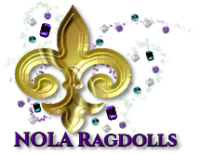About The Ragdoll Cat
![]() The Ragdoll is a cat breed is a blue eyed cat with a distinct colorpoint coat. It is a large semi-longhair cat with a soft and silky coat. Like all long haired cats, Ragdolls need grooming to prevent mats in their fur. It has a docile and gentle temperament and affectionate nature. The name “Ragdoll” was started because of the tendency of the cats from the original breeding stock to go limp and relaxed when picked up.
The Ragdoll is a cat breed is a blue eyed cat with a distinct colorpoint coat. It is a large semi-longhair cat with a soft and silky coat. Like all long haired cats, Ragdolls need grooming to prevent mats in their fur. It has a docile and gentle temperament and affectionate nature. The name “Ragdoll” was started because of the tendency of the cats from the original breeding stock to go limp and relaxed when picked up.
The Ragdoll was developed by Ann Baker, an American breeder in the 1960’s. Ragdoll cats often are known as “dog-like cats” or “puppy-like cats” because they have a tendency to follow people around, they love to be touched and handled, they get along with most other pets.
 Description
Description
The Ragdoll is one of the largest domesticated cat breeds, with a sturdy body, large frame, and proportionate legs. A fully-grown female weighs from 8 to 15 pounds. Males are substantially larger, ranging from 12 to 20 pounds or more.
The genes for point coloration are responsible for the blue eyes of the Ragdoll. More intense shades of blue are favored in cat shows. Although the breed has a plush coat, it consists mainly of long guard hairs, while the lack of a dense undercoat results, according to the Cat Fanciers’ Association, in “reduced shedding and matting”.
Ragdolls come in 6 different colors: red, seal, chocolate and the corresponding “dilutes”, including blue, lilac, and cream. This also includes the lynx and tortoiseshell variations in all colors and the three patterns. Ragdoll kittens are born white; they have good color at 8–10 weeks and full color and coat at 3–4 years.
 The 3 Patterns
The 3 Patterns
Colorpoint – One color darkening at the extremities (nose, ears, tail, and paws).
Mitted – Same as pointed, but with white paws and abdomen. With or without a blaze (a white line or spot on the face), but must have a “belly stripe” (white stripe that runs from the chin to the genitals) and a white chin. Mitted Ragdolls, which weren’t allowed titling in CFA until the 2008-2009 show season, are often confused with Birmans. The easiest way to tell the difference is by size (the Ragdoll being obviously larger) and chin color (Mitted Ragdolls have white chins, while Birmans have colored chins), although breeders recognize the two by head shape and boning.
Bicolor – White legs, white inverted V on the face, white abdomen and sometimes white patches on the back. (Excessive amounts of white, or “high white”, on a bicolor is known as the Van pattern, although this doesn’t occur nearly as often as the other patterns.)
 Variations
Variations
Mink – Mink Ragdolls can be traced back to the very first ragdolls by Ann Baker and other IRCA breeders. Contrary to what some people think, mink ragdolls are indeed purebred and are officially acknowledged by the SBT(Studbook Tradition) and The International Cat Association. YES, Minks are purebred SBT and TICA registered Ragdolls.
Mink Ragdolls are born with color, unlike traditionals which are born all white. The Mink Ragdoll has a gorgeous aqua(blue-green) eye coloring. They also have that same lovely, large, docile, floppy and people friendly personality just like traditional ragdolls.
Sepia – Like the Minks, Sepia lines also go back to IRCA lines. At birth sepia kittens are even darker than mink kittens. Sepia kittens are the same colors/patterns as the minks just darker. Their eyes are usually green, gold or copper. The sepia’s points are dark with the body color near but not quite the same as the point color. Sepia kittens are purebred, acknowledged and registered with TICA just like Minks and Traditional Ragdolls are. They also have that wonderful Ragdoll temperament that we love so much!
Lynx – A variant of the above type having tabby markings.
Tortoiseshell or “tortie“– A variant noted for mottled or parti-colored markings in the above patterns.
 References & Standards:
References & Standards:

